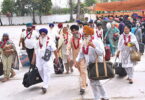Rafiullah Mandokhail
ZHOB: Despite a chilly cold day in the mid-winter. It is a special day of the season, every single villager-covered in warm clothes is busy in slaughtering a sheep or lamb at home which was grazed and feed in the last few months with special care.
Usually sheep is specially fattened and slaughtered on this day. It is decided unanimously as soon the winter makes its presence felt. The trend and tradition is still alive not only in rural but also in urban Pashtoon dominated areas. This trend has now gained popularity in other parts.
The animal which is slaughtered and its special mutton that called ‘Landi’, also known as ‘Parsanda’. It is liked to provide warmth, strength and comfort during the entire chilly winter season. Landi is actually dried mutton – the only favorite cuisine in chilly days of winter in highly mountainous areas including the historical district Zhob that shares borders with Afghanistan and Wazirstan. The valley falls on the route of Afghan nomads locally known as ‘Kochis’, who temporarily stay with their cattle here. The Kochis with thousands of goats and sheep migrate from neighboring Afghanistan to Punjab in winter and Afghanistan in summer vice versa. Majority of Zhob population depends upon livestock besides agriculture. Even in the urban areas people have cattle in their houses.
If you are living here, it doesn’t matter whether you are poor or belong to a well-off family, you must have a ‘Landi’ in winter season. Zhob that shares borders with South Waziristan and Afghanistan is one of the coldest parts of the province.
The best time to prepare Landi is December-January. If it is cold enough, the meat dries out within fifteen days. It is commonly eaten on cold nights to keep the eater warm and help to face the chilly weather.
The tradition of Landi emerged when the residents of remote and cut-off hilly areas needed fresh meat and their areas were disconnected with cities due to heavy snowfall and it was difficult to approach the bazaars and get fresh food items including meat and vegetables.
Slaughtering a sheep or lamb is common but a cow is quite rarely slaughtered. The selected animal is especially fattened for the purpose. Grazing in the grass besides additional amount of grains, wheat and wild olive are also provided.
Zia Mandokhail, resident of Killi Wiyala along Zhob River says after slaughtering the animal, the family members including children and women start plucking the hair from the lamb skin, so that all hair is completely removed. Sometimes the hair is removed with scissor before slaughtering. The viscera is removed from its abdomen and then sewn. An open fire using bushes of twigs is now ready. The carcass is then signed by flame of bushes and cattail locally known as ‘Lukhay’. After the singeing the skin often becomes a crispy layer on top of it. Then it is washed outside and inside to remove the blood, dirt, ashes etc. The bones of the carcass are removed in a very artistic way that the meat remains in the carcass.
The carcass is cut in pieces, salted and pierced by a wooden stick OR rope and hang on wooden bars to dry in the mid of the yard that is shady, airy and dry place. The pieces are hanged and exposed to the air. It is also rubbed with pungent-smelling asafetida, which is a little like garlic and serves as a preservative, a much-needed additive in those areas where electricity and refrigerators are unavailable.
It often takes about a month for the meat strips to dry throughout, but some people start eating the meat before it is fully dried. It is normally eaten when it is extremely cold. The dried pieces are taken out for cooking according to the need and offered to the family members and guests. It is served as special winter dish.
The cooking method or recipe is very simple. The meet is boiled in hot water for a while to wash the additional salts used for preservation. Later on it is cooked in a muddy cooker locally known ‘Kataw’ or pressure cooker. The meat is boiled in water and some herbs and spices are also added. The soap of Landi meat is prepared from boiling and it is used to soak the bread pieces. The Landi meat is also prepared with rice.






